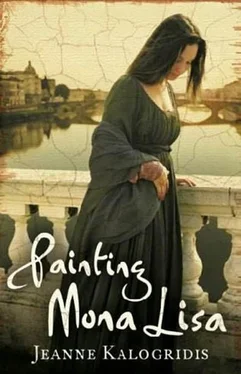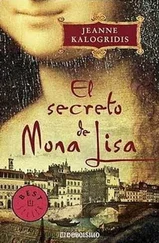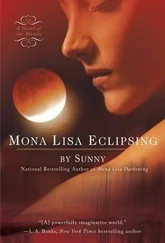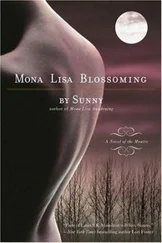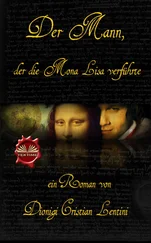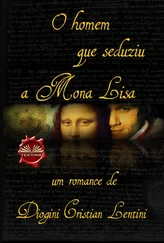Who are some of your favorite historical figures?
My namesake, Joan (in French, Jeanne) of Arc-yes, she was deluded, but she kicked butt and made a man a king. I read a lot of biographies of strong women when I was growing up; I admired Marie Curie, Elizabeth Blackwell (first female M.D. in the U.S.), Elizabeth I, Boudicca (who gave the Imperial Roman army a run for its money), Jane Addams, and Susan B. Anthony.
There are, of course, fascinating men. I always adored Leonardo because he was passionately interested in everything and pursued knowledge without the encumbrance of a formal education. Vlad the Impaler is another favorite of mine, for much grislier reasons, as is Cesare Borgia.
“While I adhered to my historical time line-to the very day, where the Medici and other historical figures were involved-I took advantage of the freedom offered by Lisa’s relative anonymity.”
Are you currently working on another book? And if so, what-or who-is your subject?
Yes, I’m working on The Bloodiest Queen , a novel about Catherine de’ Medici. When I was working on I, Mona Lisa , I became fascinated by the Medici family, and so did some extracurricular reading. Catherine was a brilliant, shrewd, strong woman who overcame a horrific childhood to become queen of France. I was immediately drawn to her for three reasons: first, she is arguably the most capable, intelligent person ever to rule France; second, she is blamed for the worst bloodshed in French history, the St. Bartholomew’s Day Massacre; and third, she was obsessed by the occult and an intimate of Nostradamus.

***
The Medici Family of Florence: A Time Line
April 26, 1478
Lorenzo’s brother, Giuliano de’ Medici, is murdered in the cathedral of Santa Maria della Fiore

December 1479
Leonardo da Vinci sketches the executed Bernardo Baroncelli

March 15, 1479
Recorded date of Lisa di Antonio Gherardini’s birth

1482
Leonardo leaves Florence for Milan

April 8, 1492
Lorenzo de’ Medici dies

November 8, 1494
Piero de’ Medici and his brothers are expelled from Florence
Medici brothers eventually settle in Rome

November 17, 1494
Charles VIII of France and his army enter Florence
March 5, 1495
Lisa Gherardini marries Francesco del Giocondo

February 7, 1497
Savonarola’s “bonfire of the vanities”

April 7, 1498
The infamous “trial by fire”

May 23, 1498
Savonarola executed

December 28, 1503
Piero di Lorenzo de’ Medici drowns in the Garigliano River

August 1512
Giuliano di Lorenzo de’ Medici welcomed home as Florence’s ruler

March 11, 1513
Giovanni di Lorenzo de’ Medici elected Pope (Leo X)
1516
Leonardo travels to France. King Francis I purchases the Mona Lisa . The painting remains in France at the Louvre Museum to this day.
Brucker, Gene A.
Renaissance Florence .
Berkeley: University of California Press, 1983.
Gatti, Claudio, in association with the
International Herald Tribune .
Florence in Detail: A Guide
for the Expert Traveler .
New York: Rizzoli, 2003.
Kent, F. W.
Lorenzo de’ Medici and the Art of Magnificence.
Baltimore: The Johns Hopkins University Press,
2004.
Letze, Otto and Thomas Buchsteiner.
Leonardo da Vinci: Scientist, Inventor, Artist.
Ostfildern: Hatje Cantz Publishers, 1997.
Martines, Lauro.
April Blood: Florence and the Plot
Against the Medici .
New York: Oxford University Press, 2003.
Vasari, Giorgio.
The Lives of the Artists .
New York: Oxford University Press, 1998.
da Vinci, Leonardo.
A Treatise on Painting .
Amherst, N.Y.: Prometheus Books, 2002.
1. Few works of art are as romanticized, celebrated, and reproduced as the Mona Lisa . How did reading this book teach you about-or change your impression of-the art world’s most famous face? Has anyone in the group ever seen it in person?
2. Beautiful, enigmatic, sly, foreboding…many adjectives have been used to describe Lisa’s portrait. But what words would you use to describe Lisa’s character? Also, take a moment to talk about her role-as an only daughter, married woman, and member of the upper class-in Florentine society. How was Lisa different from other women of her era? Do you think she was a woman ahead of her time?
3. Lisa is told by her astrologer that she is “caught in a cycle of violence, of blood, and deceit.” To what extent does Lisa let fate dictate her actions? Do you believe in fate? Discuss the themes of prophecy in I, Mona Lisa .
4. In addition to being religious, many of those we meet in the book become fanatic-and commit acts of violence to justify their beliefs. What was it that led Antonio, Baroncelli, and Savonarola to behave the way they did? Do you condone any of their actions? Do you have any sympathy for them?
5. Who do you think bears the true responsibility for the deaths of Giuliano the Elder and Anna Lucrezia? How do the various characters-from Lisa to Antonio to Lorenzo-deal with the guilt, trauma, and mystery surrounding the deaths of those they love?
6. What is significant about the third man involved in Giuliano’s murder? How does this element of mystery drive the narrative?
7. I, Mona Lisa is a novel about truth and beauty, art and artifice. It is also about family-in all its glory and bloodshed. How important is the notion of family to each of the main characters? Which relationships are the most “real” to you in this book?
8. Do you believe that a picture is worth a thousand words? Can a work of art-a painting, a book-ever truly capture a person’s essence? Did Leonardo’s portrait of Lisa capture hers?
Читать дальше
Конец ознакомительного отрывка
Купить книгу
